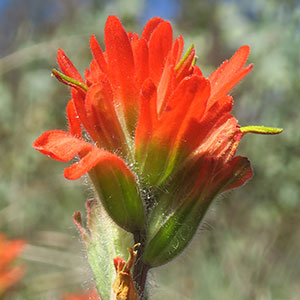Castilleja brevilobata
Castilleja organorum
short-lobed paintbrush
Organ Mountain Indian paintbrush, Organ Mountains paintbrush
solitary or few, erect or ascending, unbranched, sometimes branched, hairs spreading, short, medium, and long, soft, short and medium ones short stipitate-glandular.
several to many, erect to sprawling, usually profusely branched, including many small, leafy axillary shoots, hairs dense, retrorse, medium length, stiff, eglandular, distally spreading, long, soft, sometimes matted, very short-glandular.
green or ± yellow, lanceolate, elliptic, or oblong to narrowly ovate, 1–2(–2.5) cm, not fleshy, margins plane or wavy, involute, (0–)3–5(–7)-lobed, apex rounded to acute;
lobes ascending to erect, linear to lanceolate, apex rounded to acute.
green, linear-lanceolate, distally sometimes broadly lanceolate, 2–4.5 cm on main branch, 0.5–1 cm on proximal part of side branches, not fleshy, margins plane, involute, sometimes flat, 0-lobed, apex acute to acuminate.
3–20 × 2–3.5 cm;
bracts proximally greenish to dull brown, distally red, orange-red, or scarlet, sometimes orange or yellow, broadly lanceolate or oblong, (0–)3–5-lobed;
lobes ascending, broadly to narrowly lanceolate, short, arising above mid length, apex acute, obtuse, or rounded.
2–4.5(–14 in fruit) × 1.5–4 cm;
bracts proximally greenish, distally red to reddish orange, broadly lanceolate to oblong, 0(–3)-lobed;
lobes ascending, lanceolate, short, arising above mid length, apex acute to obtuse.
straight, 15–24(–26) mm;
tube 12–16 mm;
beak exserted, abaxial lip equal to calyx;
beak adaxially green or ± yellow-green, 7–10 mm, puberulent, stipitate-glandular;
abaxial lip deep green, reduced, rounded, 1–2 mm, 10–25% as long as beak;
teeth incurved to erect, light green, 0.5–1 mm.
slightly curved, 15–24 mm;
tube 10–13 mm;
beak exserted, adaxially green, 6–10 mm;
abaxial lip green, reduced, slightly pouched, sometimes visible in front cleft, 0.5–1.5 mm, 15–20% as long as beak;
teeth incurved, white or green, 0.4–0.7 mm.
green or whitish with green veins, lobes colored as bract lobes or paler, 14–30 mm;
abaxial and adaxial clefts 5.5–8.5 mm, 30–40% of calyx length, deeper than laterals, lateral 1.5–4 mm, 20–25% of calyx length;
lobes oblong to narrowly triangular, apex obtuse to rounded.
proximally pale green to pale yellow-green, distally pale red to red-orange above middle, 12.5–20.5 mm;
abaxial and adaxial clefts 6–9 mm, 33–50% of calyx length, deeper than laterals, lateral (1.5–)3–4 mm, 20–35% of calyx length;
lobes lanceolate or broadly triangular, apex acute.
= 24.
Castilleja brevilobata
Castilleja organorum
Castilleja brevilobata is endemic to dry serpentine openings in the Siskiyou Mountains of southwestern Oregon and adjacent California. Although sometimes treated as part of C. applegatei or C. hispida, its morphology does not suggest a close connection with either. This species occasionally hybridizes with C. pruinosa in Del Norte County, California.
(Discussion copyrighted by Flora of North America; reprinted with permission.)
Castilleja organorum is endemic to the Organ Mountains of Doña Ana County. Reports from the mountains of the Mogollon Rim of east-central Arizona and adjacent New Mexico are based on specimens of C. nelsonii. Castilleja organorum is grouped with C. linariifolia by some authors (for example, G. L. Nesom 1992c), but it has subequal abaxial and adaxial calyx clefts and is more likely closely related to C. integra. Castilleja organorum differs from the latter species in its loose, often profusely branched habit, more compact inflorescences, and usually smaller corollas. In Fillmore Canyon, C. integra, C. lanata, and C. organorum are all found, but each is in a different habitat, and there is no sign of hybridization.
(Discussion copyrighted by Flora of North America; reprinted with permission.)


